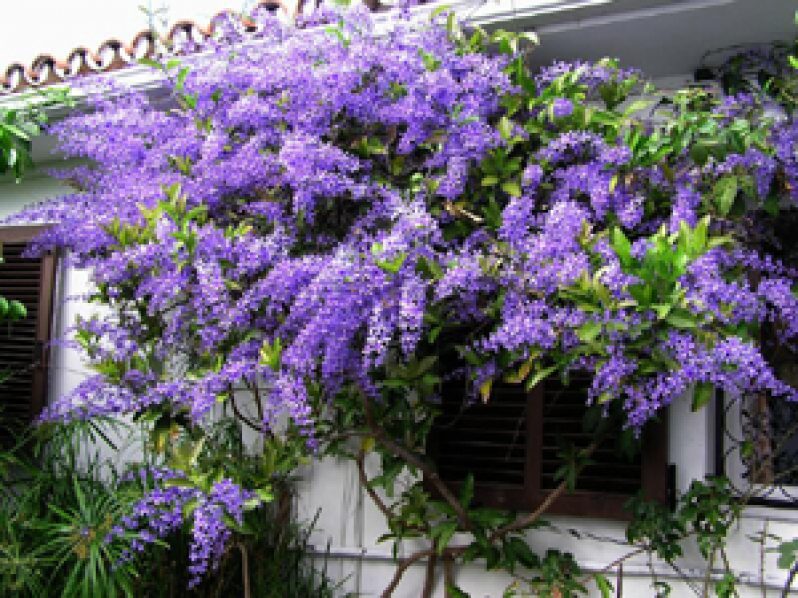Petrea volubilis: The Sandpaper Vine
THE “Sandpaper Vine”, whose botanical name is Petrea volubilis, is a twining vine with rough green leaves and spectacular clusters of purple flowers borne on short stalks (raceme) reaching over one foot long.  Also known as “the purple wreath”, it is one of the most outstandingly beautiful cultivated climbers. Somewhat resembling a wisteria, another popular climbing vine which is native to Mexico and Central America, this fast-growing, woody vine with a grey bark is native to the Eastern United States and to China, Korea, and Japan.
Also known as “the purple wreath”, it is one of the most outstandingly beautiful cultivated climbers. Somewhat resembling a wisteria, another popular climbing vine which is native to Mexico and Central America, this fast-growing, woody vine with a grey bark is native to the Eastern United States and to China, Korea, and Japan.
Left unpruned, it attains great height, and covers a considerable area. The oval leaves are quite large — between five and nine inches — and are deeply veined. Stiff and rough, they are a dull-green above, but are brighter underneath. New leaves are a fresher green but are also stiff – never soft and limp like the young leaves of most plants.
The starlike flower is a small, five-petalled affair of deep purple velvet. One purple petal has a white splash in the middle.
The eye-catching parts of each flower are the five narrow petal-like lobes that persist long after the darker purple corollas drop.
These flower sprays spring from the axils of the leaves, and are usually pendent and gracefully arched.
The tapering clusters bear many pale, blue-mauve stars, becoming deeper in colour towards the end. They grow nearly in pairs on a short stem, and usually turn so that each flower faces the light.
The name Petrea was given to commemorate the name of Lord Petre, who, in the 18th Century, became famous for his wonderful collection of exotic plants. The word volubilis means “twining.” One of the common names, “Fleur de Dieu”, means “Flower of God”; another – “Sandpaper Vine” – refers to the rough leaves. The Purple Wreath was introduced from tropical America to other tropical areas many years ago, and has always been popular as a garden shrub. Widely grown throughout the Caribbean, and variously in the tropics and subtropics, the Purple Wreath was cultivated as landscape specimen in Dominican homes, especially on the Atlantic Coast.
The Purple Wreath was introduced from tropical America to other tropical areas many years ago, and has always been popular as a garden shrub. Widely grown throughout the Caribbean, and variously in the tropics and subtropics, the Purple Wreath was cultivated as landscape specimen in Dominican homes, especially on the Atlantic Coast.
The Petrea is usually used as a climber, but grows well over a support, where it is encouraged to twine around its own branches.
The star-like flowers are extremely effective when massed.
Over a porch or along a fence, it makes a glorious show when its innumerable, long, mauve flower sprays appear.
Without a climbing support, the Sandpaper Vine becomes a self-supporting, billowing, mounded shrub. Planted under a tree, it will climb up through the tree and make a wonderful display of flowers throughout the canopy.
It also makes a terrific container patio plant, and is well-suited for hanging baskets.
Petrea volubilis comes in two varieties. The one called Purple Wreath is the more common. The Purple Wreath flower really has two colours involved. The flower petals are bright blue and last about a week before falling off, leaving lavender sepals that remain for a much longer period.
Petrea volubilis Albiflora is the second variety.
Albiflora is very hard to find. Its common name is White Petrea, but many people use the same common names as the blue form. The blue form and the Albiflora variety both have the same growth habits. The only difference is that the Albilflora form has a showy, white flower and sepals, instead of the blue and lavender.
Time was when many gardens, in Georgetown in particular, boasted the Sandpaper Vine either climbing up on roofs, or overhanging fences, or in hanging baskets. Those days are regrettably long gone, and this once popular climber is a rare sight locally.
A gardening enthusiast now in her senior years recalled with nostalgia the days when the Sandpaper Vine was an eye-catching section of gardens in many Georgetown homes.
“When I was a small child going to school at Sacred Heart Roman Catholic School, people used to have them in their gardens, hanging over the fences; pink, white, mauve; all the colours, and oh so beautiful to look at. Now you don’t see them anymore.
“I think we should encourage gardeners to resume cultivation of this climbing vine. It is easy to grow. It will be a real treat for any garden.”




.jpg)









